Adrian Collins's Blog, page 38
October 28, 2024
REVIEW: The Bog Wife by Kay Chronister
I didn’t know that Appalachian gothic folklore was a weird and wonderful subgenre of horror that I needed in my life. But after team GdM has loved stories like Lee Mandelo’s The Woods All Black and Smothermoss by Alisa Alering, I couldn’t pass up another disturbing read set in this wild place. The Bog Wife by Kay Chronister is an entirely unexpected read, equal parts compelling, unnerving, and hard to describe without giving too much of the plot away. I shall try my best!
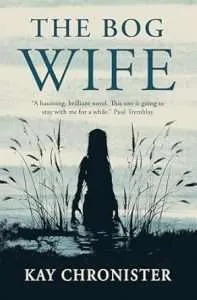 As far as the Haddesley siblings know, their family has been the custodians of their bog in the heart of West Virginia for generations. They look after the bog, and in turn, the bog provides for them – including the provision of a wife for each generation’s heir. A bog wife made of sticks, peat, and other swamp detritus to carry on the family line. When the bog fails (whether as a snub or because of an inability they do not know) to provide the next bog wife, everything they have ever known crumbles around them.
As far as the Haddesley siblings know, their family has been the custodians of their bog in the heart of West Virginia for generations. They look after the bog, and in turn, the bog provides for them – including the provision of a wife for each generation’s heir. A bog wife made of sticks, peat, and other swamp detritus to carry on the family line. When the bog fails (whether as a snub or because of an inability they do not know) to provide the next bog wife, everything they have ever known crumbles around them.
Each sibling has a different view of how the family must go on. Charlie, the eldest son, was passed over to inherit and has never felt an affinity with the land. Eda, the eldest sibling, tries to lead what remains of her family through this trying time. Wenna is the only one who has left their home and feels herself being unwillingly dragged back into a life she fought so hard to escape. Younger son Percy intends to carry on the compact and retreats further into the bog. The youngest child, Nora, takes desperate measures to keep them together.
I found The Bog Wife to be an unsettling but engaging read. It gave me the same sort of feeling as when you watch a documentary about cults – it’s not comfortable, but you can’t stop until you reach the end. I’ve never read Chronister’s work before, so I can’t comment on whether The Bog Wife is typical of her writing style, but I found it an effortless world to slide into. The story flowed well, and Chronister’s rich descriptions of the setting created a vivid location in my mind. I accept that some readers may have help with this if they are familiar with West Virginia or the Appalachian region, but I’ve got little pre-existing knowledge of the area, and I enjoyed her depiction of it.
As with any multiple-POV novel, it takes a little while to get the characters straight in your mind, and The Bog Wife is no exception. I do find that all the Haddesley siblings are well-developed characters, though they all seem a lot younger to me than they are meant to be in the novel. I think this must be intentional, though, a sign of their isolated and cultish upbringing. It is these elements that I found the most disturbing in the novel. The almost instinctive desire to protect and heal these odd and neglected children was a strong factor in keeping me reading The Bog Wife.
Many of the dark aspects in the novel are psychological, like viewing the siblings’ upbringing as neglectful. There is an undertone, a near continuous feeling of unease while reading, rather than outright bursts of violence or dark actions. Chronister makes slight references to something that her characters do not fully understand, but we, the reader, do, and it feels like a tiny stab of revelation that so much more is wrong here than we first thought.
The Bog Wife is an eerie supernatural story, and even now that I have finished it, I will be mulling it over for a while. It deals with complex issues of familial loyalty and the secrets they hold, delicately blended with a folk horror tale. Thank you to Kay Chronister and both Titan and Counterpoint, who sent Grimdark Magazine ARCs of The Bog Wife so that we could provide this review.
Read The Bog Wife by Kay ChronisterThe post REVIEW: The Bog Wife by Kay Chronister appeared first on Grimdark Magazine.
October 27, 2024
The Best Halloween Movies & TV: Screen Scares for the Spooky Season
Last Updated on October 28, 2024
It’s the time of the year when there isn’t anything more fun than sitting in front of a screen and watching something that is attempting to scare the hell out of you! Here at Grimdark Magazine, we love a good scare and here is a list of some of the best Halloween film and TV shows that get our seal of approval if you are looking for some good horror. So turn out the lights, get the popcorn ready, and peer through your fingers as we bring you some of the best scares for spooky season!
Alien

I had to start with this one. Ridley Scott’s film about a crew stranded with a deadly alien that is slowly killing them off one by one is one of the best films in building tension. Alien is a sci-fi masterpiece that brings scares in a variety of forms. It has aspects of body horror, a slasher movie, psychological horror and more. The practical effects and the creative designs of the alien based on the terrifying works of H.R Gieger has given the film longevity that hasn’t been the case for some CGI-heavy films in recent years. The alien feels reals and that makes the audience root for Sigourney Weaver’s powerful Ripley even more. Now is a good time to return to this classic, especially with the recent release of the brilliant Alien: Romulus which takes the franchise back to its simple horror roots.
Watch the trailer for Alien here.
A Quiet Place

The sequel and spin-off prequel are also quality but it’s the first offering from John Krasinski A Quiet Place that stands out as a near perfect film and one of the best movies to pick for Halloween. A mother and father struggle to keep their family alive following an invasion of sightless aliens with sharp hearing. Even the smallest of sounds will cause of death and the unique concept created one of the best cinema experiences I have ever been in – you don’t want to be the person munching popcorn in this film. The use of sound is incredible throughout the film and the foreshadowing is done to perfection. Monitor your heart rate during this film as it’s as tense as it gets. Sci-fi brilliance with a brilliant cast and a fresh concept. You’ll be exhausted by the end.
Watch the trailer for A Quiet Place here.
Let the Right One in/Let Me In

Vampires aren’t scary anymore, are they? But they are always a good choice for a Halloween movie night. The Swedish vampire horror Let the Right One In is the anti-Twilight. It uses its winter Sweden setting perfectly to create a film about isolation and loneliness as a young (in looks anyway) vampire befriends a twelve-year-old boy and helps him enact brutal revenge on his bullies. It takes a lot of the fantasy aspect out of the vampire concept and relies on a more realistic, brutal horror to create a compelling film that will live long in the memory. The American remake Let Me In featuring a young Chloe Grace Moretz and Kodi Smit-McPhee is almost a shot-for-shot remake and definitely worth a watch in its own right. A beautifully dark film with a very human take on vampires.
Watch the trailer for Let the Right One In here and Let Me In here.
Rec

If you’re a fan of found-footage horror, this one is for you. This Spanish horror gets up close and personal with a film crew trapped in an apartment block under lockdown. At first, everything is unclear but soon it is clear that everyone is trapped in the apartment block because it is ground zero of a zombie outbreak (and these zombies are terrifying!). The characters are smarter than most in horror films (see Cabin in the Woods for the best explanation for this) and the final few minutes of the film will scare the hell out of you. An incredible horror film filled with shots that will never leave your mind and make of a memorable Halloween movie pick.
Watch the trailer for Rec here.
28 Days Later

A zombie film (or is it?) from Danny Boyle with Cillian Murphy in his breakout role. Murphy’s Jim wakes up in a deserted London due to the spread of a rage infection making its way around. Heavily influenced by the great zombie masterpieces of yesteryear (Night of the Living Dead, Return of the Living Dead…), 28 Days Later asks some big questions and the real horror is looking at the lives of the humans who have survived and what they have done to be able to survive. Another sequel is on the way, it’ll be interesting to see if it can live up to the quality of the first.
Watch the trailer for 28 Days Later here.
Train to Busan

It could have been called Zombies on a Train. It’s not, but that’s what it’s about. Simple and effective. This Korean horror unleashes zombies in the tight confines of a train travelling to Busan (funnily enough…) and revels in the way the different characters respond to the deadly threat. There are scares and brutal moments mixed in with some truly emotional beats. We’ve known that Korea can produce some great horror and this zombie movie became an instant classic when it was released.
Watch the trailer for Train to Busan here.
All of Us are Dead

Zombies from the small screen work well for a Halloween watch too! The obvious choice here would have been The Walking Dead but Korean series All of Us are Dead feels fresh even if it does wear its influences clearly on its blood-soaked sleeve. Trapped in school, high-school students need to get inventive to take on the horde of zombies tearing through the building and the city. With a second season just around the corner, use your Halloween to watch the brilliant first season.
Watch the trailer for All of Us are Dead here.
The Haunting of Hill House

I could have picked anything by Micky Flanagan but this show is horror perfection. The reimagining of Shirley Jackson’s novel features excellent performances from the whole cast and the scares-per-episode ratio is higher than almost any other mainstream show. It follows a family dealing with the trauma of surviving living in a haunted house and their return. There are hidden ghosts, terrifying jumps, and psychological horror all wrapped up in an expertly written series. If you haven’t watched it, what are you waiting for? It’s an awesome choice to watch for Halloween.
Watch the trailer for The Haunting of Hill House here.
Happy Halloween from the Grimdark Magazine Team
The post The Best Halloween Movies & TV: Screen Scares for the Spooky Season appeared first on Grimdark Magazine.
October 26, 2024
REVIEW: A Monsoon Rising by Thea Guanzon
In A Monsoon Rising, Thea Guanzon picks up right where The Hurricane Wars left off, thrusting readers back into her electric South East Asian inspired fantasy world. To those who have yet to read The Hurricane Wars, I’d suggest stopping here and picking it up immediately, then circling back to this review! In this sequel, Alaric and Talasyn continue their dance of deception with their arranged marriage steering the helm of their respective political schemes. Whilst Talasyn plays the part of Alaric’s Empress, her comrades continue to strategise their plot to overthrow Alaric’s reign. Similarly, but unbeknownst to his wife, Alaric’s marriage to the Nenavarene Lachis’ka is simply a preface to his father’s much darker and sinister plan. But something much more pressing is quickly arriving: The Moonless Dark, a cataclysmic event that can only be stopped with Alaric and Talasyn’s joint effort of their Lightweaver and Shadowforged powers. Filled to the brim with tension and the devastating allure of uncontrollable emotions, A Monsoon Rising is a force to be reckoned with in the enemies-to-lovers game.
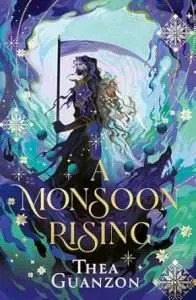 A Monsoon Rising places a strong emphasis on the romance between Alaric and Talasyn. What first began as a reluctant alliance between the two, is now transformed into a full-blown partnership that then sets the pace for the rest of the novel. The angst and tension are still palpable, but with a solidity behind it that can only come with the type of chemistry Guanzon concocts for her protagonists. The growth of each character is so organic, both in their own personal developments and their relationships with each other. Their actions align with their values, moulded to their character developments, feeling very natural. Readers are given two solid and well-rounded characters, both individually and as a pair. Alaric and Talasyn are a true treat in the realm of romantic fantasy. Guanzon really fills the readers cup of all the swoon-worthy action you’re hoping to see between the couple, especially after the first book. Truly, I devoured it.
A Monsoon Rising places a strong emphasis on the romance between Alaric and Talasyn. What first began as a reluctant alliance between the two, is now transformed into a full-blown partnership that then sets the pace for the rest of the novel. The angst and tension are still palpable, but with a solidity behind it that can only come with the type of chemistry Guanzon concocts for her protagonists. The growth of each character is so organic, both in their own personal developments and their relationships with each other. Their actions align with their values, moulded to their character developments, feeling very natural. Readers are given two solid and well-rounded characters, both individually and as a pair. Alaric and Talasyn are a true treat in the realm of romantic fantasy. Guanzon really fills the readers cup of all the swoon-worthy action you’re hoping to see between the couple, especially after the first book. Truly, I devoured it.
The grimdark element is lighter here than in the first book, but we are still privy to some difficult and quietly dark scenes. I would have loved to seen more of the politics in play, as well as more court intrigue now that the couple are the heads of their households, both domestically and politically. Due to the lack of political intrigue and the abundance of romance in play here, the story is more character-driven than plot-driven, which makes sense if we’re driving towards what I imagine will be an exploding third and final book. I feel like this gives us a reprieve, almost like the calm before the storm (see what I did there? Hah.), as we gear up for the finale.
I have to mention one of the greatest elements to this series so far: the dragons. We are initially introduced to the dragons in The Hurricane Wars, which felt quite premature, since we never really got to see them again after their introduction. In A Monsoon Rising however, they are featured multiple times, in both casual and climactic scenes, and with all the fiery glory that dragons deserve. It is widely agreed that dragons are absolutely glorious creatures in every grimdark medium they are presented on, and Guanzon’s interpretation of them does not disappoint! I can’t wait to see them in action again in the next instalment.
I am always at awe with Guanzon’s writing. She manages to capture emotions so profoundly, and with the grace of a seasoned writer. It’s hard to believe that this is only her second book! Whilst book one rounded off in quiet anticipation, readers will be left stunned at the cliffhanger Guanzon has ended her sequel in. Echoing the same sentiment from my review of the The Hurricane Wars: the third book is my most anticipated read of 2025, and it has yet to even have a name.
Read a Monsoon Rising by Thea GuanzonThe post REVIEW: A Monsoon Rising by Thea Guanzon appeared first on Grimdark Magazine.
October 25, 2024
REVIEW: The Ending Fire by Saara El-Arifi
After delivering one hell of a debut in The Final Strife and following that up with one of the strongest sequels in The Battle Drum, Saara El-Arifi had set the bar incredibly high for the epic conclusion in The Ending Fire. Now war has officially arrived at the Wardens’ Empires shores, and we are launched into a slightly messy but bloody satisfying finale that pulls zero punches and delivers tragedy and triumph in equal measure.
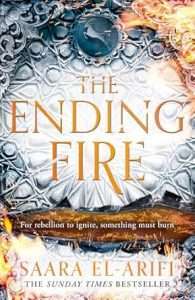 Look, El-Arifi proved to me in the first two books of this series that she is already a true master at her craft, but we all know that it’s rare for a finale to perfectly stick the landing, let alone a finale to a debut series. Needless to say, I went into The Ending Fire equally nervous and excited, hoping against all hope that all my favourite chaos queers would get their happy ending.
Look, El-Arifi proved to me in the first two books of this series that she is already a true master at her craft, but we all know that it’s rare for a finale to perfectly stick the landing, let alone a finale to a debut series. Needless to say, I went into The Ending Fire equally nervous and excited, hoping against all hope that all my favourite chaos queers would get their happy ending.
In many ways, I think The Ending Fire contained all the best elements of this visionary series and delivered on what was promised and set up in the first two books. Much like in the second instalment, our favourite perfectly imperfect characters find themselves separated against their will, fighting their own battles both within and without. Sylah and Hassa find themselves navigating the dangerous politics within the Wardens’ Empire where a mysterious vigilante is stirring up trouble, Jond is trying to bring war allies from overseas, and Anoor is taking up her role as the prophesied Child of Fire under the Zalaam’s oppressive thumb.
Now, I think these characters would be the first to admit that they are anything but perfect, but that relatable human messiness is exactly what made me love them so much in the first two instalments. However, in The Ending Fire, I felt like some of their satisfying and well-earned character growth was almost reversed a bit, and they started to test my patience just slightly too much with their questionable and frustrating actions. Moreover, while I appreciated how the separation of the characters in The Battle Drum allowed the world to expand and the characters’ individual arcs to shine, I personally thought it started to hinder both the development of the interpersonal relationships and my personal emotional investment in The Ending Fire.
Especially Anoor’s storyline in this finale had me feeling a bit conflicted, despite the fact that I deeply appreciate what El-Arifi tried to do with her character. The exploration of religious zealotry, cultism and indoctrination was quite powerfully executed, but her gullibility and ignorance just felt a bit too convenient and unbelievable for how savvy she had proven to be in the first two books. And as a result of Anoor’s tragic circumstances, I felt like a large part of Sylah’s entire personality was reduced to little more than “I am Anoor’s lover and I need to save her because there is no world and life without her”, which I found understandable for her character but nevertheless slightly disappointing.
Luckily, I could count on my girl Hassa to pull me through the rocky moments, and she just absolutely stole the show for me once again. The way that she continues to fight (in the shadows) through so much adversity despite her limitations was so empowering to see, and I honestly think she has the best character arc of anyone in this entire trilogy. Though while I personally wouldn’t hesitate to say that The Ending Fire is Hassa’s book, I also feel like I have to give some credit to Jond. See, I was stunned by how much I came to really enjoy Jond’s perspective in this finale, and I consider that a huge testament to El-Arifi’s skill as an author considering how much I loathed him in the first (and part of the second) book. His dynamic with Kara really entertained me, and their romantic tension proved to be a nice counterbalance to the unending yearning from Sylah and Anoor.
As the big climax drew near and the threatening (but undeniably cool) innovative blood magic creations/weapons were geared up for an epicly devastating showdown, I found myself getting surprisingly anxious and emotional over the fates of these characters despite my exasperation with them for large parts of this book. El-Arifi did a magnificent job of weaving together all the loose plot threads, resolving both the internal and external conflicts in a surprising but satisfying way. And although I was personally not the biggest fan of how messy and anti-climactic the final battle felt due to the sudden switch to perspectives from people we had never seen before, I can appreciate such a bold storytelling move and ultimately liked how it showcased the devastating impact of the war on all the little people outside of our (anti)-heroes’ lives.
Despite some of my quibbles with the execution of this finale, I can’t deny that I absolutely devoured this finale and found it to be a fittingly imperfect and beautifully bittersweet conclusion to The Ending Fire trilogy. Seeing how far these scarred characters have come since we first met them in The Final Strife tugged on my heartstrings in all the most unexpected ways, and I truly think El-Arifi succeeded in pulling off her ambitious vision for this story. I absolutely consider this one of my favourite series, and I will always be grateful to El-Arifi for helping change the landscape of the fantasy genre to a more diverse and inclusive space to escape into.
So, if you like the sound of a brutally dark yet delightfully fun fantasy tale set in a richly immersive African/Arabian-inspired world full of conspiracies and secrets, featuring beautifully queer and diverse characters who are way too snarky for their own good, and brimming with fascinating blood magic that will excite, delight, and freak you the fuck out, then I can’t recommend The Ending Fire trilogy highly enough. This is a journey I won’t soon forget.
Read The Ending Fire by Saara El-ArifiThe post REVIEW: The Ending Fire by Saara El-Arifi appeared first on Grimdark Magazine.
October 24, 2024
REVIEW: The Year’s Best Dark Fantasy and Horror (Volume 5) by Paula Guran
One of the highlights of October’s spooky season is the release of Paula Guran’s annual short story anthology, The Year’s Best Dark Fantasy and Horror. With over fifty short story anthologies and a slew of awards to her credit, Paula Guran is an undisputed queen of her craft. Although it is titled, The Year’s Best Dark Fantasy and Horror (Volume 5), the current volume is actually Guran’s fifteenth entry in the series, since the numbering was reset after switching publishers to Pyr Books five years ago.
 Every short story by A.C. Wise is a treat. As the first entry in The Year’s Best Dark Fantasy and Horror (Volume 5), Wise’s psychological horror “The Dark House” is no exception. “The Dark House” concerns a photographer’s obsession with the eponymous house, which he uses exclusively as a darkroom for developing photographs. But the images that develop reveal more than expected.
Every short story by A.C. Wise is a treat. As the first entry in The Year’s Best Dark Fantasy and Horror (Volume 5), Wise’s psychological horror “The Dark House” is no exception. “The Dark House” concerns a photographer’s obsession with the eponymous house, which he uses exclusively as a darkroom for developing photographs. But the images that develop reveal more than expected.
Another standout story is “All the Things I Know About Ghosts, By Ofelia, Age 10” by Isabel Cañas. There is something about a young child’s perspective that makes a horror story even more terrifying, and the Bram Stoker Award-nominated Isabel Cañas delivers in spades with her juxtaposition of innocence and fear in a flooded town.
Alaya Dawn Johnson’s contribution to The Year’s Best Dark Fantasy and Horror (Volume 5) is “The Witch Is Not the Monster,” a futuristic ecological horror concerning generations of witches living along the Potomac River. This story grabbed me from the opening line and held me in its spell till the very end.
“The Demon Lord of Broken Concrete” by Alex Irvine is another standout story in this year’s collection. Irvine blends the everyday with the bizarre in this tale about a school-aged boy in the 1980s, overlaying religious occultism with schoolyard and family drama.
“Midnight in Moscow” by Tobi Ogundiran is a special treat, brilliantly blending Russian folklore into a tale told by a Nigerian narrator residing in Moscow. Tobi Ogundiran’s writing is simply magical, making this story one of my favorites in the collection.
Other noteworthy stories in The Year’s Best Dark Fantasy and Horror (Volume 5) include “Interstate Mohinis,” M.L. Krishnan’s tale of a woman killed on an Indian highway; “Return to Bear Creek Lodge,” the mournful wintry horror by Tananarive Due; and the offbeat family tale, “The Tissot Family Circus,” by Angela Slatter.
Rounding out the anthology are “The Crease” by Simon Avery, “Miz Boudreaux’s Last Ride” by Christopher Caldwell, “Resurrection Highway” by A. R. Capetta, “Those Hitchhiking Kids” by Darcie Little Badger, “If Someone You Love Has Become a Vurdalak” by Sam J. Miller, “Kudzu Boy Dreaming” by S.J. Powell, “A Geography of Innocence” by M. Rickert, “Till the Greenteeth Draw Us Down” by Josh Rountree, “Jack O’Dander” by Priya Sharma, “Significant Disruption” by R.L Summerling, and “The Ghasts” by Lavie Tidhar.
Altogether, The Year’s Best Dark Fantasy and Horror (Volume 5) is another highly recommended anthology for horror fans in search of a new favorite short story. Paula Guran’s anthology is a great way to discover new authors and revisit established favorites.
Read The Year’s Best Dark Fantasy and Horror (Volume 5) by Paula GuranThe post REVIEW: The Year’s Best Dark Fantasy and Horror (Volume 5) by Paula Guran appeared first on Grimdark Magazine.
October 23, 2024
REVIEW: Dragon Age: Vows & Vengeance
Last Updated on October 24, 2024
With the upcoming release of Dragon Age: The Veilguard, BioWare has released an immersive audio drama on most major podcast platforms. Dragon Age: Vows & Vengeance is an eight episode audio drama that takes place before the events of The Veilguard. One of the major selling points about the series is the companion characters that accompany the player created character, and each episode of Vows & Vengeance introduces one of the new companion characters that are found in The Veilguard.
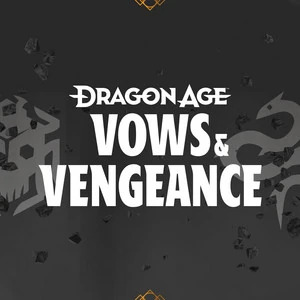 Vows & Vengeance stars Nadia Carcosa, voiced by Mae Whitman of Avatar: The Last Airbender and Good Girls fame. She’s a former thief who left her life behind for the love of her life, the charming Tevinter mage Elio. However, Nadia gets whisked away for one last job to steal a magical artifact by a former friend, which goes sideways once Solis, the companion/antagonist from Dragon Age: Inquisition gets involved. Elio is dragged into the Fade, and Nadia joins with the writer and scholar Drayden to find a way to bring him back.
Vows & Vengeance stars Nadia Carcosa, voiced by Mae Whitman of Avatar: The Last Airbender and Good Girls fame. She’s a former thief who left her life behind for the love of her life, the charming Tevinter mage Elio. However, Nadia gets whisked away for one last job to steal a magical artifact by a former friend, which goes sideways once Solis, the companion/antagonist from Dragon Age: Inquisition gets involved. Elio is dragged into the Fade, and Nadia joins with the writer and scholar Drayden to find a way to bring him back.
I like that each episode of Vows & Vengeance features one of the new companions from The Veilgaurd that Nadia interacts with. This podcast is a great way to get to know each companion character before meeting them in the game. Each episode feels like its own genre or twist on grimdark fantasy: Nadia joins Taash for a dragon hunting adventure and meets with Lucanis the Antivan Crow assassin for a Home Alone-inspired mansion defense. Speaking of grimdark, Dragon Age has had some growing pains over the years, going from a dark fantasy in Dragon Age: Origins to a more traditional heroic fantasy in Inquisition, but that doesn’t deter things from getting bloody and morally gray. Nadia is an interesting character whose past is not a clean one, and you get to see how all of that plays out through the story.
This being an audio drama, Vows & Vengeance strategically uses its soundtrack and sound effects to draw you into the story. There were a handful of times where I wasn’t quite sure what was happening simply because a character didn’t describe what they were doing (and even if they did describe what they were doing, the dialogue usually felt stiff or awkward), but those moments felt few and far between. The overall ending of the story was wrapped up a little too quickly and cleanly for my taste, but since each episode feels like a complete story from beginning to end, I didn’t much mind this.
Vows & Vengeance is a wonderful way to meet Dragon Age: The Veilguard’s companions. It certainly has me picking favorites for who I’ll be taking along during my playthrough of the game.
The post REVIEW: Dragon Age: Vows & Vengeance appeared first on Grimdark Magazine.
October 22, 2024
REVIEW: The Battle Drum by Saara El-Arifi
Look, I’ve made it no secret that I adored The Final Strife, but El-Arifi truly takes everything that was so bloody brilliant about the first book and cracks it up to eleven in The Battle Drum. The prophesied ending fire is looming ever closer, and now our favourite crew of flawed yet loveable chaos queers will have to choose between duty and desire to save their world from total destruction; cue the emotional turmoil!
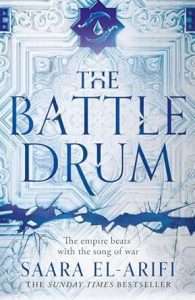 The Battle Drum picks up almost immediately where the first book left off, sucking us straight back into the messy lives of our three fierce female leads. I was nervous to see if El-Arifi would be able to keep the story as engaging without the action-packed and high-stakes trial element that made The Final Strife so addictive, but I should never have worried. Although the pacing slows down significantly, the expansion of the world and the development of the characters and their interpersonal relationships quickly prove to be infinitely more captivating than any trial or battle could ever be.
The Battle Drum picks up almost immediately where the first book left off, sucking us straight back into the messy lives of our three fierce female leads. I was nervous to see if El-Arifi would be able to keep the story as engaging without the action-packed and high-stakes trial element that made The Final Strife so addictive, but I should never have worried. Although the pacing slows down significantly, the expansion of the world and the development of the characters and their interpersonal relationships quickly prove to be infinitely more captivating than any trial or battle could ever be.
For me, this sequel absolutely shines in its character work, and I thought it was very exciting to see Sylah, Hassa and Anoor all go off on their own personal journeys. These three ladies all absolutely have my heart, not because they are so perfect and loveable, but exactly because they are so relatable in their deep flaws and human messiness. And the entire cast of side characters also just pops off the page with personality, offering plenty of characters who you can love, hate, love to hate or hate to love. At times I didn’t know if I wanted to hug, strangle, shake or slap them all (okay maybe except for Jond, who gets his own POV here; he definitely deserved to be slapped), but that is exactly why they feel like real people to me and why I am so invested.
Now, I’ll admit that I was initially a bit nervous about the fact that some of my favourite characters were separated in this instalment, but in hindsight I think that was exactly what this story and the characters needed to live up to their full potential. While I did end up preferring Hassa and Sylah’s exciting storylines way more than the slightly lacklustre murder mystery plot line in Anoor’s life, I seriously can’t point to a single dull moment in this book. El-Arifi has a true gift for creating compelling and complex relationships of all natures that tug on your heartstrings, so it truly doesn’t matter who is together on the page, because every single scene just hits. And don’t get me started on all the casually queer love, the romantic tension is just absolutely delicious in here (can we get a Hassa and Kwame spin-off series? Thank you very much).
But as if all that wasn’t enough, we’re also treated to a very intriguing and mysterious new POV in The Battle Drum that I was both fascinated and slightly terrified by. At first this new addition threw me off a bit, but it soon became so much fun trying to figure out who this person was and how their storyline would interweave with all the others; if you pay close enough attention, you can pick up on the breadcrumbs and puzzle the pieces together yourself, which made for such a satisfying and rewarding reading experience.
This book is just full of crazy twists and turns that will keep you on the edge of your seat the entire way through, and especially the revelations about the world building and magic system were jaw-dropping. I already loved this vibrant African/Arabian inspired world from the few glimpses we’d gotten of it in The Final Strife, but it was truly awe-inspiring to realise the full depth and breadth of this world here as Sylah travels outside of the Wardens’ Empire. There’s so much mystery and intrigue woven into the history, lore, religion and magic of these lands, and I loved seeing everything start to unravel as our characters made some truly shocking and earth-shattering discoveries. Familiar tropes like prophecy and chosen ones are also incorporated into the story in new and clever ways, which just makes The Battle Drum one of the most unpredictable and refreshing modern fantasy stories.
Now, fair warning, El-Arifi does not shy away from the darker and more disturbing content. The stakes are immensely high, and I really appreciated that the characters really have to deal with the repercussions of their (questionable) actions in The Battle Drum. Difficult themes of racism, discrimination, classism, gender identity, sexuality, disability, addiction, toxic (familial) relationships and religious zealotry are all explored in meaningful and deep ways with effortless grace, all without ever feeling on-the-nose or overbearing. This might only be El-Arifi’s second book, but I wouldn’t hesitate to call her a master of her craft already.
All in all, I think this is one of the better sequels that you will find in the fantasy genre. If you liked The Final Strife, then I truly can’t see how you won’t enjoy The Battle Drum. El-Arifi’s visionary storytelling is a true breath of fresh air in the fantasy genre, striking the perfect balance between the fun, wonder, wit, disgust, despair and undying resilience and hope. The Ending Fire trilogy is quickly becoming one of my new personal favourites, and I can’t wait to see how it will all wrap-up in the finale.
Read The Battle Drum by Saara El-ArifiThe post REVIEW: The Battle Drum by Saara El-Arifi appeared first on Grimdark Magazine.
October 21, 2024
REVIEW: The Radleys
One of the latest vampire films to hit the market, its release perfectly timed to make the most of the spooky month of October, is The Radleys, directed by Euros Lyn. You can catch it in the UK in a limited cinematic release, or if you subscribe, on Sky Cinema or NOW TV. I started watching The Radleys with no more knowledge than the trailer gave me, and my strong-held opinion is that Damian Lewis, who plays two characters in this film, is a great actor, so it should be worth watching.
 Now, had I known before that The Radleys is an adaptation of a contemporary fiction novel, not a horror novel, I would have had very different expectations about it. But I didn’t have that knowledge prior, and as the film went on, it became apparent that this film was less horror and more dark comedy with some blood spatter. As someone who was after a dark and brooding vampire film (and considering that the synopsis describes it as a ‘vampire thriller’), I find that The Radleys was not the best film to pick.
Now, had I known before that The Radleys is an adaptation of a contemporary fiction novel, not a horror novel, I would have had very different expectations about it. But I didn’t have that knowledge prior, and as the film went on, it became apparent that this film was less horror and more dark comedy with some blood spatter. As someone who was after a dark and brooding vampire film (and considering that the synopsis describes it as a ‘vampire thriller’), I find that The Radleys was not the best film to pick.
The film follows the eponymous Radley family, a vampire family that abstains from blood drinking. The Radley parents, mild-mannered doctor Peter, played by Lewis, and housewife Helen, played by Kelly Macdonald, constantly struggle to keep their addiction under control and have also chosen to keep their vampiric natures a secret from their teenage children, Clara and Rowan.
This parenting strategy backfires somewhat when a stressful situation causes Clara to lash out and kill, becoming a blood drinker in the process. Peter then calls in his estranged brother, the violent louche, “active vampire” Will (also played by Lewis), to help clean up the mess.
There are some things that The Radleys has done well. Damian Lewis’ double role was good to watch, with him giving each twin different mannerisms and movements and them both having very different styling to show their disparities. The film’s younger leads, Bo Bragason as Clara and Harry Baxendale as Rowan, perform very well. Harry Baxendale’s performance as a closeted gay teen struggling to find his place in the world was very well done.
Overall, The Radleys missed the mark for me, and I suspect it will be the same for anyone who starts watching it wanting a modern vampire thriller. It initially held a lot of promise (opening with scenes of Whitby and early bloody violence), but this dribbled away as the film continued. I found it not particularly dramatic but only slightly funny, so I can’t even truly describe The Radleys as a dark comedy.
The main actors in The Radleys perform well, given what they’ve had to work with, and as the main reason I watched it was because of the casting, that’s a small win. But if you are after a new movie that is going to be a great addition to the vampire movie pantheon or are searching for a deliciously dark watch to sink your teeth into, The Radleys isn’t the one to watch.
The post REVIEW: The Radleys appeared first on Grimdark Magazine.
October 20, 2024
REVIEW: Sleepwalking by Daniel Barnett
Well, I guess that’s it then… with Sleepwalking, Daniel Barnett has officially become a new favourite author and established The Nightmareland Chronicles as one of my all time favourites; this series is truly my horror dream (or should I say nightmare?) come true.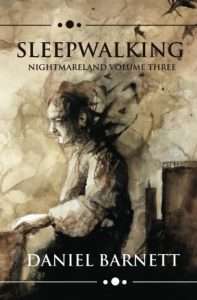 If the previous instalment, Lullaby, was Mariah’s book, then Sleepwalking is Marcos’ book. Never before have I enjoyed a child character as much as I do Marcos, and it’s truly insane how deeply emotionally invested I have become in him in the short time since we first met him. He is somehow both extremely emotionally mature for his young age while also maintaining an endearing level of childhood innocence, which is exactly what makes him such a surprisingly complex and compelling kid.
If the previous instalment, Lullaby, was Mariah’s book, then Sleepwalking is Marcos’ book. Never before have I enjoyed a child character as much as I do Marcos, and it’s truly insane how deeply emotionally invested I have become in him in the short time since we first met him. He is somehow both extremely emotionally mature for his young age while also maintaining an endearing level of childhood innocence, which is exactly what makes him such a surprisingly complex and compelling kid.
Not to mention, the deaf and (child of) illegal immigrants experience are both extremely beautifully and authentically explored through his eyes, making me empathise with him on a level that should not even be possible considering our completely different lived experiences. I found it especially touching and inspiring to see how Marcos’ deafness almost becomes his biggest strength in this post-apocalyptic nightmare world, helping him escape the dire threat of the soft yet malicious lullaby that is lulling humanity to sleep.
Moreover, the dynamic between Marcos and Mariah just tugged on my heartstrings in all the most unexpected ways, and I love the unconventional yet powerful exploration of motherhood and (found) family in Sleepwalking. As nightmares of the dead start to manifest and they get hunted and haunted by monsters both human and supernatural, their uniquely strong connection becomes their shared guiding light that drags them through the darkness.
And oh damn, do things get dark and violent in Sleepwalking. This instalment combines the King-esque southern small town horror of Nightfall and the more inexplicable supernatural horror of Lullaby, and the horrific visual imagery unsettled me in new ways I was not ready for. Barnett’s evocative wordsmithery just continues to creep deeper and deeper under my skin, and Adam Gold’s exceptionally enthralling narration of the audiobook once again kept me in a chokehold from beginning to end.
Somehow, I don’t even mind that I am once again left with more new mind-boggling questions than satisfying answers, because the level of mystery, intrigue and looming dread is exactly what makes this series so dangerously addictive to me. And after that shocking and diabolical ending, I am beyond excited to see what Barnett has in store for this odd yet loveable found family of broken souls. I seriously cannot say enough good things about The Nightmareland Chronicles, so just trust my word for it and embark upon this epic horror journey for yourself already; you can thank me later.
Thank you to the author for providing me with an audiobook ARC in exchange for an honest review. All opinions are my own.
The post REVIEW: Sleepwalking by Daniel Barnett appeared first on Grimdark Magazine.
October 19, 2024
REVIEW: Terminator Zero
Taking the Terminator franchise in a new direction, Terminator Zero sets the story in Japan in different years (of course) and moves away from live action to the world of animation. Can the new direction jolt some life into a dying franchise or is this effort just another reason for not wanting Terminator to say, “I’ll be back.”?
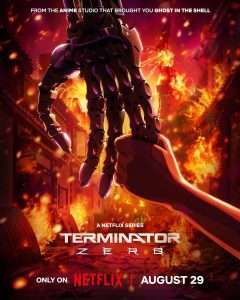 In a dystopian 2022, Eiko battles a Terminator and hacks it to gather data around Skynet’s plans. Following this, she meets the leader of the resistance, The Prophet, who gives Eiko an important mission to travel back in time to 1997 to prevent workaholic scientist Malcolm Lee from creating an advanced AI system called Kokoro that could threaten the world. Terminator Zero does feel fresh for a franchise that has been struggling for sometime. Taking the approach that worked so well with Prey and the Predator series, moving the story away from the United States and the familiar characters allows the story stand on its own and the quality of animation is just another example of why the best stories are being told through this medium (Arcane, Castlevania, Cyberpunk: Edgerunners, Blue Eye Samurai).
In a dystopian 2022, Eiko battles a Terminator and hacks it to gather data around Skynet’s plans. Following this, she meets the leader of the resistance, The Prophet, who gives Eiko an important mission to travel back in time to 1997 to prevent workaholic scientist Malcolm Lee from creating an advanced AI system called Kokoro that could threaten the world. Terminator Zero does feel fresh for a franchise that has been struggling for sometime. Taking the approach that worked so well with Prey and the Predator series, moving the story away from the United States and the familiar characters allows the story stand on its own and the quality of animation is just another example of why the best stories are being told through this medium (Arcane, Castlevania, Cyberpunk: Edgerunners, Blue Eye Samurai).
There are twists and turns aplenty throughout the series as there often is with time travel stories but Terminator Zero generally keeps things simple to its benefit. Malcolm’s story is an interesting one as he discusses the purpose of humanity with his AI Kokoro and though the philosophical conversations are mostly surface level stuff, there’s nothing jarring in their discussions that take you out of the story. Malcolm himself turns from a man who is quite robotic, working all the time and ignoring his children, to someone who is a bit more human as the reasons for his actions unfold. The action in the series never disappoints with fights between humans and Terminators along with Kokoro’s forces taking place both in 1997 and in the dystopian future. We see how humans react in fear with sudden changes in their world and the violence that ensues at a time when Malcolm is trying to persuade Kokoro that humanity is worth saving and isn’t always violent. It creates an action-packed and pacy series sprinkled with moments of quiet and reflection that comes together to create the best Terminator media since Arnie lowered himself into lava with a thumbs up. As with most animated series, the voice cast needs to be spot on to keep you focused on the story and Terminator Zero is pure quality in this regard.
Terminator Zero will brink back fans of James Cameron’s franchise who might feel a little burned by recent efforts. A new location and the use of animation allows the story to breathe new life into the franchise and allows Terminator Zero to stand well clear above the recent efforts in film. Terminator Zero proves that we can bring the franchise to life with a story full of action that focuses on what it means to be human. I’m hoping it isn’t too long until it’s back.
The post REVIEW: Terminator Zero appeared first on Grimdark Magazine.



